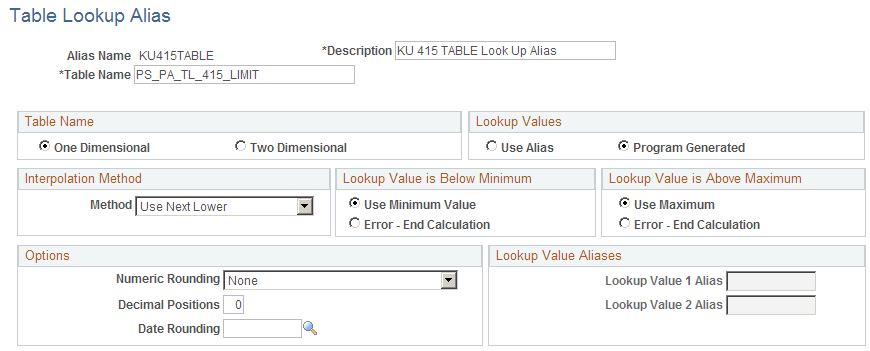Setting Up a Table Lookup Alias
To set up a table lookup alias, use the Table Lookup Alias component (TABLE_LOOKUP).
|
Page Name |
Definition Name |
Usage |
|---|---|---|
|
PA_TBL_LOOKUP |
Set up a table lookup alias for searching a table. |
Use the Table Lookup Alias page (PA_TBL_LOOKUP) to set up a table lookup alias for searching a table.
Navigation:
This example illustrates the fields and controls on the Table Lookup Alias page.

Field or Control |
Description |
|---|---|
Table Name |
Enter the name of the table that stores the information you want to search. The table name must begin with PS_PA_TL_. |
Table Name
Field or Control |
Description |
|---|---|
One Dimensional or Two Dimensional |
Select One Dimensional to look up the result based on a single lookup value—for example, to look up the social security retirement age, based on the date of birth. Select Two Dimensional to look up the result based on two lookup values—for example, to look up the factor that converts a single life annuity to joint and survivor, based on both the participant age and the beneficiary age. |
Lookup Values
Field or Control |
Description |
|---|---|
Use Alias |
Select to indicate a regular table lookup, which looks up information once. |
Program Generated |
Select to indicate a program-generated table lookup, which looks up information for each period. |
Interpolation Method
Select Higher, Linear, Lower, or Nearest as the method for handling intermediate values on a table.
For example, for the following social security retirement age table, select Lower. To look up the SSRA for someone born August 16, 1944, you would find the next lowest value on the table, January 1, 1938, and use the associated SSRA.
|
Birth Date |
SSRA |
|---|---|
|
December 31, 1937 |
65 |
|
December 31, 1954 |
66 |
|
December 31, 1955 |
67 |
In another example, for the following hours-to-service table select Linear. Then 1000 hours is worth .5 years of service. If you use any other interpolation method, you probably need additional rows in the table.
|
Hours |
Service |
|---|---|
|
500 |
.25 |
|
2000 |
1.00 |
Lookup Value is Below Minimum and Lookup Value is Above Maximum
Each or these group boxes offers a choice between taking the lowest (or highest) value and ending the calculation with an error. For the SSRA example, select Use Minimum Value and Use Maximum Value. For other tables, you might select Error - End Calculation.
Lookup Value Aliases
For a regular table lookup—that is, if you choose Use Alias to find the lookup values—you have to specify the lookup value aliases. To look up SSRA, the lookup basis is the employee's birth date, accessed through the database alias BIRTH_DT. The same principle applies to all table lookups that are not program generated: The lookup basis is always another alias. If you set up a one-dimensional table, you only specify a value in Lookup Value 1 Alias. If you are setting up a two-dimensional table, you also need to specify a value in Lookup Value 2 Alias.
Options
Field or Control |
Description |
|---|---|
Numeric Rounding |
Select the rounding method the system is to use if the lookup produces a number:
|
The following table compares the behavior of the two rounding settings. These examples assume that the final value has two decimal positions.
|
Number |
No Rounding (Always Truncates) |
Round Up (Rounds Up or Down) |
|---|---|---|
|
5.444 |
5.44 |
5.44 |
|
5.555 |
5.55 |
5.56 |
|
5.666 |
5.66 |
5.67 |
Field or Control |
Description |
|---|---|
Decimal Positions |
For both numeric rounding options, None and NumRndUp, enter the number of decimal positions. |
Date Rounding |
Select a date rounding method if the lookup produces a date. |